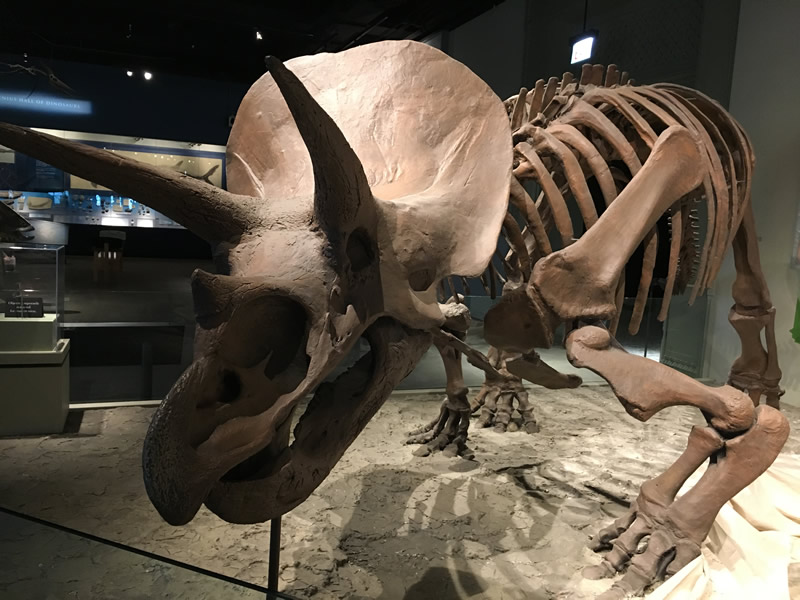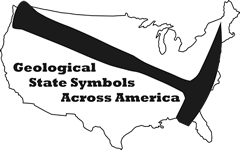Wyoming
Type |
Symbol |
Year Est. |
|---|---|---|
State Gemstone |
Jade |
1967 |
State Fossil |
Knightia |
1987 |
State Dinosaur |
Triceratops |
1994 |
State Gemstone: Jade
Jade is a green gemstone that has a bit of an ambiguous mineralogy. It turns out that samples of gemstones that have been called jade actually fall into three different mineral categories. Typically what happens with gemstones, is that they are a name of a specific colored mineral; i.e. purple quartz is known as amethyst. Well in this instance the green gemstone jade can be one of three minerals: jadeite, actinolite, or tremolite. And even the combination of actinolite and tremolite goes by a different name: nephrite. There is a strong physical similarity between all these minerals, hence the confusion of which mineral jade could belong to and so all of these, as long as they are green, can be considered jade. All of these minerals have a hardness of 6 to 7 on Mohs Hardness Scale and all are silicates, although with significantly different chemical formulas. Jadeite is a aluminum-rich pyroxene (NaAlSi2O6) and actinolite and tremolite are magnesium-rich amphiboles (Ca2(Mg,Fe)5Si8O22(OH)2). All three of these minerals are formed through the process of metamorphism. Jadeite is a metamorphosed variety of albite, a plagioclase mineral and actinolite/tremolite are commonly formed from the metamorphism of ultramafic and mafic igneous rocks, such as those formed in oceanic crust. Due to the durability of the jade minerals, they can be formed into tools, however the green color has caused many artisans to use them more for jewelry and sculptures.
Related: Alaska State Gemstone - Jade
State Fossil: Knightia
State Dinosaur: Triceratops

Triceratops horridus skeleton and cast from the Field Museum in Chicago, IL.
The first discovery of material attributed to Triceratops, was in 1887 by George Lyman Cannon near Denver, Colorado, who had found a set of the brow horns attached to a skull roof. He sent the material to O.C. Marsh who, assuming the rock dates were Pliocene, determined that it was from a prehistoric bison, which he named Bison alticornis. However after a more complete specimen was discovered in 1888 from Wyoming's Lance Formation by John Bell Hatcher, as well as a couple of other discoveries, Marsh reevaluated the initial find and eventually added all the finds under a new species, Triceratops, which he named in 1889, meaning "three-horned face".
Ceratopsian wall at the Natural History Museum of Utah. Triceratops is the one located in the far right at the top.
Triceratops belongs to a group of animals known as ceratopsians. Ceratopsians were prolific during the Cretaceous, with many different varieties evolving with various numbers of horns and frill adornments. Triceratops was one of the last ceratopsians to have evolved with remains having been found in rocks dating from ~69 million years ago to the end of the dinosaurs ~66 million years ago. It is estimated that Triceratops could grow up to 30 feet in length and weigh 12,000-16,000 pounds. There are currently two recognized species of Triceratops, T. horridus (pictured above in Chicago) and T. prorsus. The skull of Triceratops is one of the largest skulls ever discovered, approaching 10 feet in length in some individuals and not only had the three primary horns (one above each eye and one on the snout), it also had a series of spikes along the edge of the frill known as epoccipitals, and hornlike projects on the jugals (cheekbones). The horns are thought to serve multiple functions, such as defense from predators as well mating display structures.
Related: South Dakota State Fossil - Triceratops
References
https://statesymbolsusa.org/states/united-states/wyoming
https://ninkasibrewing.com/
https://www.gbif.org/species/113684498
https://www.britannica.com/animal/Triceratops
Geology of Wyoming's National Parks
Through Pictures
(at least the one's I have been to)
Devils Tower National Monument
Fossil Butte National Monument
John D. Rockefeller, Jr. Memorial Parkway
Devils Tower National Monument
Visited in 1997
Fossil Butte National Monument
Visited in 2013
.jpg)
The obligatory entrance sign.
.jpg)
Since the park is a fossil based park, and most fossils you can't see in their "natural habitat", the best places to see the local fossils are in the visitor centers of these parks. Here we have a fossil wall of some of the spectacular fish fossils found.
.jpg)
Many of the fossil plants found in the park.
.jpg)
A crocodilian skeleton.
.jpg)
Some local turtle fossils.
.jpg)
Vertebrate fossils like lizards, bats, and a tiny early horse.
.jpg)
Panoramic view of the park from one of the highest points along the main drive.
.jpg)
First view of the Historic Quarry as we hiked up to it.
.jpg)
Up close view of the Historic Quarry as you come up on it from the main trail. The Historic Quarry is located within the Green River Formation of the Eocene. The Green River Formation is a prehistoric lake deposit from a lake known as Fossil Lake. In these deposits each layer of sediment within the rocks represents sediment that was slowly deposited over time, likely with one layer representing one year of deposition, with winter time freezing over the lake and halting deposition.
.jpg)
Me in front of the quarry.
.jpg)
View of the further side of the Historic Quarry where the trail switchbacks up to the upper layers.
.jpg)
View of some of the main fossil bearing units in the upper portion of the Historic Quarry. You can see the individual laminae pretty well from here.
.jpg)
Panoramic view of the valley standing at the Historic Quarry
.jpg)
A highlight of where to find some fossils among the many laminae of the prehistoric lake bed.
.jpg)
Entering the old fossil hunter's home.
Visited in 2010
Entrance to the park with the family.
Us getting ready for our first real hike with the few month old.
During the hike up to one of the lakes
A stream along that hike.
.jpg)
Panorama near the visitor's center.
The lake at the end of the hike first hike.
Me in Jackson Lake
.jpg)
A small hike alongside Jackson Lake.
.jpg)
Sunset from far away while driving back to the hotel.
John D. Rockefeller, Jr. Memorial Parkway
Visited in 2010
This is a bizarre "National Park" in that there is nothing to it. They wanted a park to connect Yellowstone NP with Grand Teton NP, so they made this one. There is only one place to stop and that is this "visitor's center".
The mosquitoes were so bad here I literally jumped out of the car, snapped some pictures, went inside the building for 5 second, then left. It doesn't even have its own webpage. They use part of the Grand Teton NP webpage.
Visited in 1997 and 2010
.jpg)
View of my father back in 1997 and me in 2010 during an Old Faithful eruption.
Rainbow with eruption. I'm pretty sure this is Old Faithful erupting but there was another nearby geyser erupting about the same time, so I am not positive.
Along the geyser hike looking back towards Old Faithful along Firehole River.
Some hot springs along the Geyser walk.
Lovely algae cover on the water.
Some more hot springs.
I love this spring. The water is so clear you can see right down the crack.
My wife and recently born child doing the geyser hike near old faithful.
Stopped to take a geology geek picture of the Continental Divide. However, I think the water ended up going in the same direction, so I think the sign is a bit off.
.jpg)
Panorama of Yellowstone Lake with some hot springs in the front.
.jpg)
Another view of Yellowstone Lake with the wife in the middle.
Grand Canyon of the Yellowstone.
Some formations near the Mammoth Hot Springs section of the park.
More formations near Mammoth Hot Springs.
.gif)
A buffalo was blocking traffic so I wanted to put together a slide show of him walking passed the car.
.jpg)
Me in front of one of the hydrothermal vents


